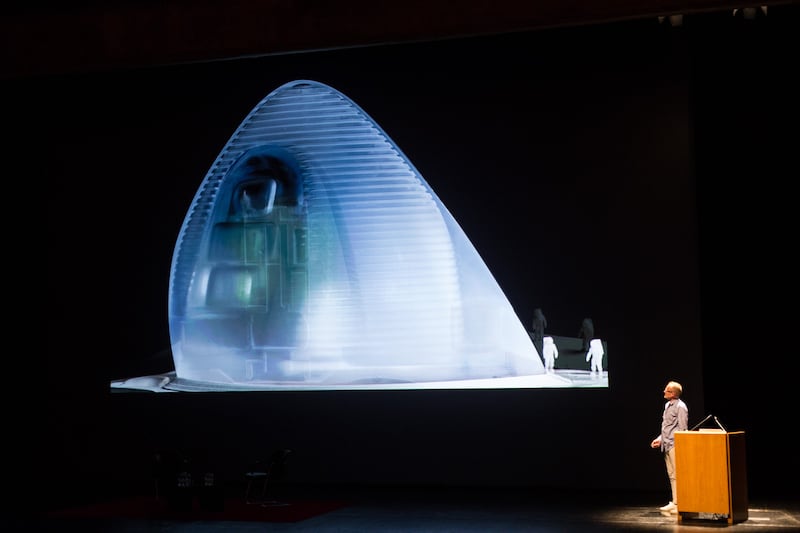This year’s Venice Architecture Biennale introduced a first: the Universe Pavilion, a space-themed exhibition exploring how we might live beyond Earth.
Designed by leading artists and thinkers from the German and Italian space sectors, the pavilion challenged traditional national showcases. It offered a timely reflection on a fast-growing idea: that space, like climate, transcends borders and that architecture might be one of our most potent tools in confronting both.
The Venice biennale is often considered the world’s most prestigious architecture exhibition. While not part of the official programme, the inclusion of the Universe Pavilion marked the first time space entered the architectural mainstream in such a high-profile setting – a signal that new frontiers are becoming future concerns.
Among those contributing to the broader momentum in space architecture were three architects whose careers collectively trace the evolution of European and transatlantic thinking in this still-nascent discipline: Dr Barbara Imhof, Michael Morris and Orla Punch.
READ MORE
Imhof and her firm presented Building With and Living Off Lunar Resources, a concept exploring how to construct habitats on the Moon using solar-sintered lunar dust.
Solar sintering uses concentrated sunlight to fuse lunar soil into solid building components, reducing the need to transport materials from Earth. “You transport machines, not materials,” Imhof explained. “You use what’s there.”
Space architecture demands a radical rethinking of how we build. It is not just about surviving in extreme environments; it is about recreating conditions for life where they naturally do not exist.
As Imhof noted, “Low Earth orbit, where the International Space Station sits, is orbiting 450 kilometres above us. The Moon is 1,000 times farther. It may seem easy to imagine travelling there because of the Apollo missions. But, honestly, we have to start from scratch.”
Imhof is one of Europe’s leading voices in space architecture. She co-founded Liquifer Systems Group in Vienna in 2004 and currently lectures at the University of Innsbruck in Austria. Her practice spans lunar design, analogue simulations and bio-integrated habitats. She has played a central role in the European Space Agency’s contribution to the Gateway, a new lunar outpost.
Gateway, led by Nasa in collaboration with ESA; the Japan Aerospace Exploration Agency and the Canadian Space Agency, is planned to orbit the Moon as a staging point for lunar missions and deep space exploration.
ESA is contributing two key elements to the Gateway: the International Habitat (I-Hab), which will house up to four astronauts for missions lasting 30 days, and the Esprit module, which will offer refuelling capabilities and advanced telecommunications.
The I-Hab is scheduled to launch in 2028 as part of the Artemis programme, Nasa’s multinational initiative to return humans to the Moon for the first time since the Apollo era.
“We’ve been working on I-Hab for five or six years,” Imhof explained. “It’s just three metres in diameter and six metres long. Every element of the design has been optimised for microgravity and safety.”
Yet the Artemis programme itself faces uncertainty. Changes in US political leadership could delay or alter its course. “No one knows what’s happening,” Imhof said. “If they cancel or delay Artemis elements, everything downstream is affected, including I-Hab.”
Even so, she believes Europe’s contributions – from communications systems to refuelling infrastructure – are essential and must be protected through long-term funding and policy commitments.
Much of the required technology is still under development. “We’re at technology readiness level five or six,” Imhof added. “This means that the project is still in its testing and laboratory phase. It takes years and considerable resources to reach TRL 9, which signifies that the system is fully tested and proven for flight operations. If politics keeps shifting, we won’t make it.”
The challenges are real. But the lessons drawn from designing for space have profound implications for Earth. “To build sustainably on Earth, we need to use local materials, reuse rubble and minimise transport emissions,” said Imhof. “That’s what space architecture teaches us because in space, we have no choice.”
This ethos also shaped the work of Michael Morris, an Irish-American architect who, with his wife Yoshiko Sato, co-founded the New York-based Morris Sato Studio.
Together, they launched SEArch+ (Space Exploration Architecture), a practice dedicated exclusively to off-world habitat design.
Morris, whose family hails from Mayo and Roscommon, has often spoke of pride in his Irish heritage, crediting it with shaping his outlook as an architect drawn to storytelling, endurance and imagination.
“Designing for space strips architecture back to a core question: how do we survive?” Morris said. “You can’t take anything for granted. That mindset is invaluable as we confront climate change and resource scarcity on Earth.”

Morris and Sato viewed space architecture not as a novelty but as a means to advance the discipline. Their work earned top honours in Nasa’s Centennial Challenge for a Mars habitat design in 2015.
A generation behind Morris and Imhof, Irish architect Orla Punch is an emerging talent in the field. In 2015, as a final-year architecture student at the University of Limerick, she designed a Martian habitat. She earned the department’s prestigious gold medal, awarded to the top student in the degree programme.
It was the first time a space-based project had earned such recognition in the school’s history, marking her as a breakout talent in the discipline. Punch then completed postgraduate training at the International Space University in Strasbourg before joining the ESA’s astronaut centre in Cologne, Germany.
There, she contributed to research under the mentorship of ESA astronaut Samantha Cristoforetti and scientist Dr Aidan Cowley as part of the Spaceship EAC project, exploring topics ranging from lunar energy systems to astronaut wellbeing and modular habitat designs.
“I was always interested in human space exploration,” Punch said. “Humans cannot survive beyond Earth without some version of a home. That idea fascinated me psychologically, materially, and environmentally.”
Today, she is an associate partner in San Francisco at Foster+Partners, a global architectural firm known for iconic buildings and pioneering space design including the Gherkin in London and Apple’s headquarters in Cupertino, California. The firm has collaborated with ESA on lunar habitat concepts and designed the Virgin Galactic terminal and hangar facility within Spaceport America in New Mexico.
In March, Foster+Partners showcased its off-world design work at the Earth to Space exhibition at Washington’s Kennedy Centre, featuring 3D-printed structures and models that link space research with sustainability on Earth.
While Punch’s work at Foster+Partners currently focuses on Earth-based dwellings, she continues to draw inspiration from space architecture. “Designing for space stretches my thinking,” she said. “And every project has the potential to change how we live, up there and down here.”
Together, these three architects offer a portrait of a discipline still in formation, one that is not yet codified or widely taught but growing in urgency and influence. In space, every drop of water counts, and so it should be on Earth. Techniques such as solar sintering, closed-loop life support systems and rubble reuse are already being integrated into sustainable building practices here at home.
At the Venice Biennale, the Universe Pavilion offered a timely reflection on this very idea. While not an official national pavilion, its inclusion signals a growing recognition that space, like climate, transcends borders.
Its creators hope that one day, the Biennale will formally include a Universe pavilion alongside national showcases. Because if space belongs to all of us, architecture may be the tool through which we shape that shared future.
And perhaps, just perhaps, these designs, once imagined for lunar soil and Martian dust, may teach us how to build better here on Earth, before it’s too late.



















